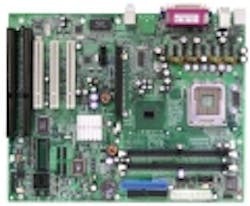Shift to Intel Core i7 processor tops the most important embedded computing stories of 2010
Top stories of 2010 -- Real-time embedded computing for aerospace and defense applications saw many changes in 2010, and one of the most notable involved the industry shift to the Intel Core i7 microprocessor after rival Freescale Semiconductor discontinued -- at least temporarily -- its support for AltiVec floating-point processing capability in its latest QorIQ processors.
Embedded computing suppliers to the aerospace and defense industry earlier this year began announcing their support for the Intel roadmap, primarily because the Intel Core i7 processor supported floating-point processing, while the Freescale QorIQ family did not. Floating-point processing is important for digital signal processing in radar, sonar, and electronic warfare applications.
Before discontinuing floating-point processing support in its QorIQ processors, Freescale had dominated digital signal processing in aerospace and defense applications. After taking a beating in the public relations wars, Freescale leaders relented and announced plans this past fall to re-introduce AltiVec floating-point processing capability in future QorIQ microprocessors.
While all this was going on, the embedded computing industry's acceptance and implementation of high-speed serial switch fabric architectures continued apace, with ever-growing reliance on technologies such as OpenVPX and VXS, as well as on fabrics such as Gigabit Ethernet, PCI Express, and RapidIO.
Despite a shaky start, embedded computing industry leaders were able to put aside their differences in 2010 to reconcile a dispute over VPX standards, and came together on a unified plan to ratify interoperability standards for VPX high-speed serial switch fabric networking architectures.
As a result of a unified industry consensus on how to move forward on modern VPX-based high-speed embedded computing architectures, design-ins for this technology are proliferating, and perhaps for the first time this year, substantial growth in VPX designs are anticipated across a broad range of aerospace and defense applications.
In fact, broadening interest in VPX and other approaches to open-systems architectures is giving rise to industry and government initiatives to come up with new open-systems embedded computing standards not only to reduce the costs of advanced technology to taxpayers, but also to create a vibrant supplier ecosystem that enables a wide variety of companies to compete for new designs on an even footing.
Looking to the future of embedded computing in aerospace and defense, the U.S. Defense Advanced Research Projects Agency (DARPA) launched programs in 2010 that focus on extreme-scale computing that eventually may yield embedded computing systems that are 1,000-times more powerful than today's fastest supercomputers.
The DARPA Ubiquitous High Performance Computing (UHPC) and Omnipresent High Performance Computing (OHPC) programs seek not only to create an revolutionary generation of computing systems that overcomes the limitations of the current evolutionary approach, but also that helps develop tomorrow's high-performance computers to meet the relentlessly increasing demands for greater performance, higher energy efficiency, ease of programmability, dependability, and security.
To tie all these developments together, Military & Aerospace Electronics in 2010 launched its online embedded computing department on the Internet, as well as the Embedded Computing Report electronic newsletter, which distributes on the second Monday of each month to bring readers up to date on the latest developments, contracts, and products in the embedded computing industry.
